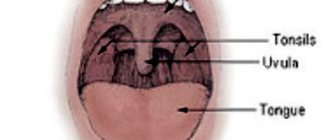Chronic tonsillitis is a chronic inflammation of the tonsils.
The palatine tonsils (popularly called tonsils) are an important part of the human immune system.
Bacteria, viruses, and microscopic fungi enter us with food and air. They settle on the mucous membranes, where they are picked up by a constant current of mucus, and this “river” flows in the direction of the oropharynx, just where the tonsils are located behind the palatine arches.
The palatine tonsils are like a sponge. They are dotted with gaps. When we swallow a bolus of food soaked in infected mucus, this mucus enters the lacunae of the tonsils. There, foreign microorganisms are attacked by the guard cells of the primary immune response: neutrophils and macrophages. The latter not only kill the infection, but also “cut” it into small molecular fragments, on which young cells of the secondary immune response—lymphocytes—are then “trained.” Prepared and trained lymphocytes emerge from the tonsils and “spread” throughout the mucous membranes of the pharynx and nose, forming a fairly reliable secondary specific defense.
Causes of chronic tonsillitis
In fact, inflammation occurs constantly in the tonsils - this is their function. But sometimes the protective resources of the tonsils are unable to cope with the infection, and then the inflammation, which gets out of control, turns into a serious disease - tonsillitis.
The acute form of tonsillitis is tonsillitis. Untreated tonsillitis often develops into chronic tonsillitis. Conversely, exacerbation of chronic tonsillitis leads to an outbreak of tonsillitis. If a person gets tonsillitis every year or several times a year, then he most likely has chronic tonsillitis.
Sometimes chronic tonsillitis can develop even if a person has not had a sore throat. This is possible if there is a source of infection that can affect the tonsils for quite a long time, for example, untreated caries or chronic sinusitis.
How to treat acute tonsillitis
A sore throat in a preschool child becomes a reason to consult a doctor, but an adult patient is often prone to self-medication. This approach predisposes to the transformation of acute tonsillitis into a chronic and complicated form.
35ef9ecf3f83207e5d6dabda7b.jpg" />
This infectious disease in an adult should also be treated under the supervision of a competent specialist. This will not only allow you to quickly cope with uncomfortable symptoms, but will also prevent the unfavorable course of the disease.
Treatment of acute tonsillitis is usually complex and may include:
- The use of topical (local, local) agents with analgesic, anti-inflammatory, antimicrobial effects. These can be lozenges, lozenges, sprays, pharmaceutical and homemade rinsing solutions. Treatment of acute tonsillitis at home in most cases is limited to the haphazard use of these remedies.
- Systemic antibacterial therapy, drugs are prescribed in the form of tablets, suspensions for ingestion or solutions for injections. Antibiotics are often required even in the case of sore throat due to ARVI, to suppress the activating opportunistic bacterial flora.
- Physiotherapy.
- Inhalations.
- Immunomodulatory therapy.
- Symptomatic drugs (for example, antipyretics, painkillers). They do not affect the course of the disease and do not change the prognosis, but they improve the patient’s well-being.
- Modern minimally invasive techniques (intratonsillar laser destruction).
Treatment of acute tonsillitis in adults and children in most cases is carried out conservatively. But the addition of purulent complications, the spread of the process to the peripharyngeal tissue may require surgical intervention (operation).
Symptoms of chronic tonsillitis
The inflammatory process in the tonsils can spread to neighboring organs, and then the person may complain of nasal congestion, sore throat, dry cough, and these secondary symptoms may be predominant.
With chronic tonsillitis, there may also be complaints of pain in the joints (knees, elbows, wrists), especially in the evening and when the weather changes, fleeting pain in the heart, a feeling of palpitations without physical activity, pain in the lumbar region. The ECG may reveal arrhythmia and tachycardia.
Such symptoms are a serious cause for concern, since they can accompany the development of severe autoimmune diseases of the kidneys, heart, and nervous system, which are complications of tonsillitis. This occurs when inflammation in the tonsils causes the immune system to malfunction; as a result, antibodies are produced, but not to the causative agent of the disease, as it should be, but to the heart muscle, joint tissue and connective tissue. When the body's defense system is upset, it tries to destroy the body itself.
The insidiousness of chronic tonsillitis also lies in the fact that it can occur without obvious symptoms. In this case, between outbreaks of sore throat, the person does not complain of anything, although a focus of inflammation remains in the tonsils.
The main symptoms of chronic tonsillitis itself are:
Sore throat
With chronic tonsillitis, there is pain in the throat when swallowing, especially in the morning. The appearance or intensification of such pain can be caused by swallowing cold food or liquid.
Feeling of discomfort in the throat
There may be no pain as such, but there may be discomfort when swallowing, a sensation of a foreign body in the throat.
Low-grade fever
With chronic tonsillitis, there may be a temperature that does not decrease over a long time (37.2-37.5°C).
Bad breath
Inflammation in the tonsils can manifest as persistent bad breath.
General weakness
Typical manifestations of chronic tonsillitis are increased fatigue, sweating, weakness, and poor health.
Treatment of sore throat at GUTA CLINIC
Treatment of tonsillitis in our clinic is carried out comprehensively, drug therapy is prescribed individually, both antibacterial and immunomodulating, decongestants, antihistamines are used, as well as physiotherapy (rinsing, washing, irrigating the tonsils with various medications).
Treatment of abscesses is only surgical followed by rehabilitation therapy. Otorhinolaryngologists at GUTA CLINICS recommend that at the first symptoms of tonsillitis - difficulty swallowing, pain and discomfort in the throat, redness of the tonsils, fever, changes in sense of smell, taste, voice - contact a specialist. Don't let your sore throat progress and stay healthy!
Treatment methods for chronic tonsillitis
It is very important to defeat chronic tonsillitis: otherwise, there remains a constant source of infection and intoxication of the entire body, not to mention the threat of severe autoimmune complications.
Home methods can reduce the severity of symptoms, but achieving a complete cure is difficult. Tonsillitis is a disease that is too complex in its nature and course. Therefore, if you suspect chronic tonsillitis, you should consult a doctor.
First of all, a comprehensive examination should be carried out to determine the pathogen and the stage of development of the disease.
Before treating tonsillitis, it is necessary to eliminate other sources of infection - cure carious teeth, inflammatory processes in the nose and paranasal sinuses. If your child often suffers from sore throats, then it is very likely that one of the family members is a carrier of the infection. In this case, it makes sense to get the whole family examined.
With complaints corresponding to the symptoms of chronic tonsillitis, you can contact a general practitioner (family doctor or therapist) or a specialized specialist - an otolaryngologist (ENT).
Children's appointments are conducted by qualified pediatricians and ENT doctors.
The Family Doctor clinics have the necessary equipment and a staff of qualified specialists to conduct examinations, establish diagnoses and perform all procedures in accordance with the prescribed course of treatment, and, if surgical treatment is required, to perform operations.
In the treatment of chronic tonsillitis the following are used:
Washing the lacunae of the tonsils
The course of treatment for chronic tonsillitis, as a rule, involves washing the lacunae of the tonsils using vacuum drainage. During rinsing, various anti-inflammatory drugs are used that penetrate deep into the tissue, destroying microorganisms that multiply in the tonsils.
Physiotherapy
In parallel with washing the tonsils, physiotherapeutic procedures (treatment with short-wave ultraviolet radiation, magnetic laser therapy, phonophoresis) can be prescribed.
More information about the treatment method
Antibacterial therapy
If chronic tonsillitis is caused by a bacterial infection, it is treated with antibiotics.
More information about the treatment method
Surgery
If the inflammatory process has gone far enough, surgical treatment methods are used. At JSC “Family Doctor” you can use the modern method of laser tonsillotomy. Laser tonsillotomy is a high-energy treatment of the palatine tonsils, in which only the affected part of the tonsils is removed. The tonsils themselves are preserved, if possible, which is very important for the immune system. In the most severe cases, the tonsils are completely removed.
Make an appointment Do not self-medicate. Contact our specialists who will correctly diagnose and prescribe treatment.
Rate how useful the material was
thank you for rating
Complications of tonsillitis (tonsillitis)
Sore throat is one of those diseases that cannot be endured “on your feet”.
Indifference to your health if you have a sore throat is criminal; hoping for help from “folk remedies” and medicines from the home medicine cabinet of your friends and acquaintances is, to say the least, short-sighted. The question of treating sore throat is precisely the correct treatment. If the patient receives inadequate therapy for tonsillitis, complications may include various heart defects, kidney disease, joint damage, the transition of the inflammatory process to surrounding tissues with subsequent formation of abscesses, otitis (inflammation of the middle ear), laryngitis (inflammation and swelling of the larynx), as well as others diseases (tonsil abscess, paratonsillitis, phlegmon, meningitis, mediastinitis, purulent lymphadenitis, tonsillar sepsis, etc.).
When does a cough with tonsillitis appear?
The main causes of cough symptoms in throat diseases:
- dryness and irritation of the mucous membrane of the upper respiratory tract;
- inflammation of the nasal mucosa with copious discharge;
- damage to the trachea and bronchi.
Cough with tonsillitis is dry and suffocating, paroxysmal2. If the infection from the tonsils descends into the bronchi or affects the sinuses, a small amount of sputum may be produced. The addition of this symptom indicates that the infection is advanced and requires increased attention.
A little anatomy and physiology
The palatine tonsils are located on the side walls of the pharynx and are shaped like large almond kernels. The second name - “tonsils” - tonsils received due to their resemblance to acorns, which are called “glandulae” in Latin. Since the Latin word for tonsils is “tonsilla,” their inflammation is called tonsillitis.
The palatine tonsils belong to the organs of the immune system and are small accumulations of lymphoid tissue 2. The part of the tonsils protruding into the pharynx has depressions (lacunae), in the walls of which there are numerous slit-like pockets (crypts)1. The surface of the crypts is the “working area” of the tonsils. Basic physiological processes take place here: immune cells, phagocytes, absorb microbes that have penetrated the tonsils, “study” them, send the received information to higher departments of the immune system, and then kill the infection1. If the microbes are very aggressive and there are a lot of them, and the immune system is weakened, an infectious inflammation of the tonsils develops - tonsillitis.
Up to contents
Treatment without surgery
Conservative treatment includes general and local drug therapy, physiotherapy, lavage of lacunae and other methods of cleansing the tonsils. Antibacterial, anti-inflammatory, antiallergic, and immunomodulatory agents are prescribed.
Conservative therapy is widely used in modern otorhinolaryngology. But it does not always completely cure tonsillitis. The tonsils may remain enlarged even after drug suppression of the infection and deep cleansing; the risk of relapses and complications remains. In approximately 1/3 of patients, it becomes necessary to treat the disease surgically.
Literature
- S. Ya. Kosyakov, I. B. Angotoeva. Modern ideas about tonsillopharyngitis. Medical Council, No. 17, 2015, pp. 32-36.
- T. S. Polyakova, E. P. Polyakova. Chronic tonsillitis: diagnosis, treatment, prevention. Russian Medical Journal, No. 2, 2004, pp. 65-68.
- G. R. Kaspranskaya, A. S. Lopatin. Chronic tonsillitis: different views on an old problem. Medical Council, No. 5–6, 2013, pp. 69-71.
- Instructions for use of the drug HEXORAL® solution.
- Instructions for use of the drug HEXORAL® aerosol.
- Instructions for use of the drug HEXORAL®TABS.
- Instructions for use of the drug HEXORAL®CLASSIC.
- Instructions for use of the drug HEXORAL®TABS EXTRA.










